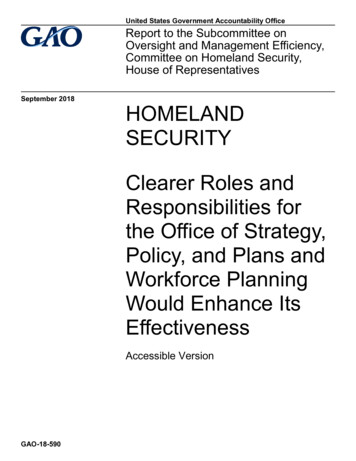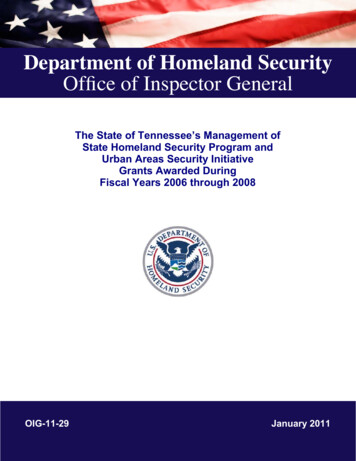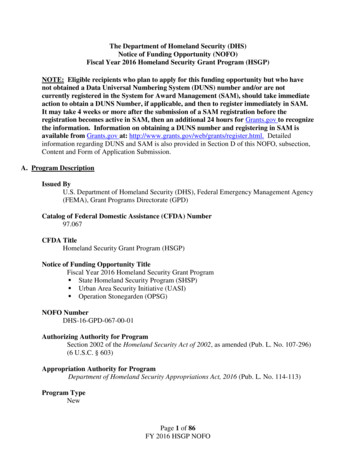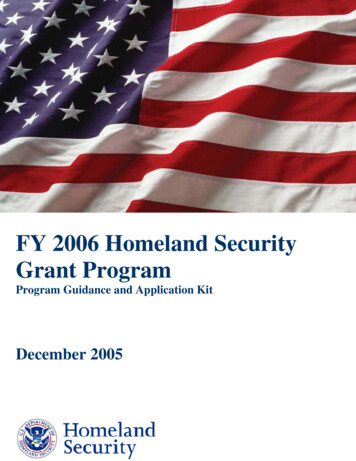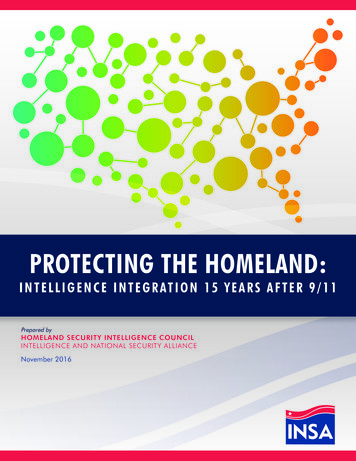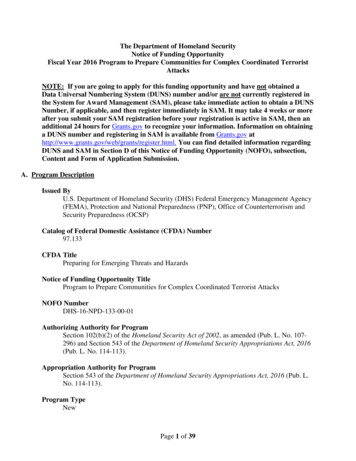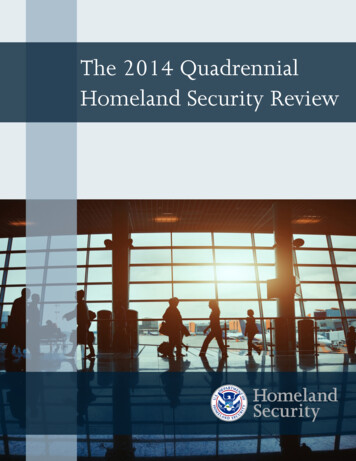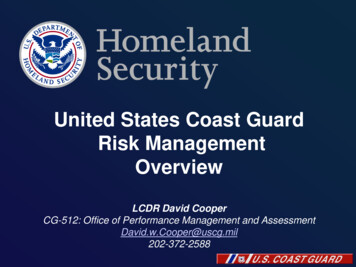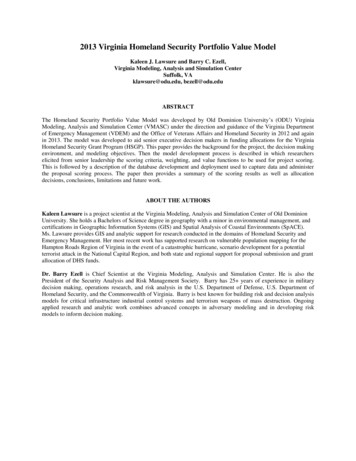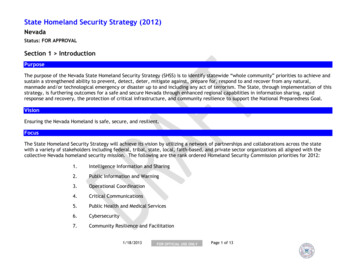
Transcription
State Homeland Security Strategy (2012)NevadaStatus: FOR APPROVALSection 1 IntroductionPurposeThe purpose of the Nevada State Homeland Security Strategy (SHSS) is to identify statewide “whole community” priorities to achieve andsustain a strengthened ability to prevent, detect, deter, mitigate against, prepare for, respond to and recover from any natural,manmade and/or technological emergency or disaster up to and including any act of terrorism. The State, through implementation of thisstrategy, is furthering outcomes for a safe and secure Nevada through enhanced regional capabilities in information sharing, rapidresponse and recovery, the protection of critical infrastructure, and community resilience to support the National Preparedness Goal.VisionEnsuring the Nevada Homeland is safe, secure, and resilient.FocusThe State Homeland Security Strategy will achieve its vision by utilizing a network of partnerships and collaborations across the statewith a variety of stakeholders including federal, tribal, state, local, faith-based, and private sector organizations all aligned with thecollective Nevada homeland security mission. The following are the rank ordered Homeland Security Commission priorities for 2012:1.Intelligence Information and Sharing2.Public Information and Warning3.Operational Coordination4.Critical Communications5.Public Health and Medical Services6.Cybersecurity7.Community Resilience and Facilitation1/18/2013FOR OFFICIAL USE ONLYPage 1 of 13
State Homeland Security Strategy (2012)NevadaStatus: FOR APPROVALThrough these initiatives, Nevada will continue to enhance a comprehensive and coordinated statewide and regional partnership of allagencies, prepared to adequately respond to any type of emergency or disaster.CoordinationThe Governor of Nevada designated the Nevada Department of Public Safety, Division of Emergency Management (NDEM) as the StateAdministrative Agency (SAA) for the Homeland Security Grant Program and related federal preparedness grant programs. The NDEMserves as the State's single point of contact in the administration of the Homeland Security Grant Program (HSGP), associated emergencypreparedness programs, and all disaster assistance programs. In November 2002, the Governor appointed a Homeland Security Advisorand in 2003, legislation was passed creating Nevada's Commission on Homeland Security.To facilitate coordination efforts, the State of Nevada has established a representative process that includes the following bodies: TheNevada Commission on Homeland Security; The Homeland Security Working Group; the Las Vegas Urban Area Working Group; and theNevada Communications Steering Committee (NCSC). To ensure the information of the SHSS is timely and accurate, administrativemeasures for review of the SHSS should occur regularly and not to exceed 24 months after the most recent assessment within any singlejurisdiction. Periodic statewide review and update of threat/risk, vulnerability and needs assessments provide the necessary informationfor effective alignment of the SHSS priorities with continued advancement of preparedness program attributes, federal grant guidance,and the national goal.Nevada Commission on Homeland Security (HSC)In 2003 the Nevada Commission on Homeland Security (HSC) was established under Nevada Revised Statute (NRS) 239C and meets at leastquarterly. The HSC has a primary goal to serve as the public body which reviews and makes recommendations to the Governor, thoughthe NDEM, on the use of money from any homeland security or related program. The HSC oversight responsibilities include; review ofcounterterrorism policies and programs, making recommendations to state and local agencies, oversight of preparedness funding to meetstatewide goals, and advising the Governor and the Legislature on Homeland Security issues.Homeland Security Working Group (HSWG)The Homeland Security Working Group (HSWG) was created by Executive Order on March 3, 2008 and amended by Executive Order 201131 on December 15, 2011. The HSWG comprises 30 members representing state, local, tribal, and public sector partners and is tasked tomake recommendations to the HSC on new and continuing homeland security grant funded projects. The role of the HSWG is to bringtogether subject matter experts from state agencies, law enforcement, tribal representatives, first responder organizations, and localgovernment to participate in an open and collaborative vetting process to select projects eligible for receiving State Homeland Security1/18/2013FOR OFFICIAL USE ONLYPage 2 of 13
State Homeland Security Strategy (2012)NevadaStatus: FOR APPROVALGrant Program (SHSGP) funding for the current federal fiscal year. The HSWG makes a project funding recommendation to the FinanceCommittee of the Nevada Commission on Homeland Security. The Finance Committee reviews the project recommendations and afterconsideration passes the final project recommendations to the Homeland Security Commission for final consideration and approval.Las Vegas Urban Area Working Group (UAWG)The Las Vegas Urban Area Working Group (UAWG) is created in fulfillment of the requirements of the U.S. Department of HomelandSecurity’s (DHS) Urban Area Security Initiative (UASI). The Las Vegas Urban Area is defined as the entire geographic area of Clark County,Nevada. In accordance with DHS guidance, membership in the UAWG must provide either direct or indirect representation for all thejurisdictions and response disciplines that comprise the defined Urban Area, including local Major Medical Response System (MMRS)leadership, Citizen Corps Council representative, and representatives responsible for the administration of the Center for Disease Control(CDC) and Assistant Secretary for Preparedness and Response (ASPR) cooperative agreements. Currently, the UAWG comprises 11members’ entities. The UAWG supports the efforts and requirements of the State Administrative Agency (SAA), Nevada HomelandSecurity Working Group (HSWG), and the Nevada Commission on Homeland Security (HSC). The UAWG considers project proposals andinvestment justifications for expenditure of annual allocations of UASI funds, and makes recommendations for approval of such projectsand investments to the State Homeland Security Commission Finance Committee.Nevada Communications Steering Committee (NCSC)The Nevada Communications Steering Committee was established by Executive Order on July 15, 2005 and amended by Executive Order2011-23 on November 28, 2011. It is through this order that the NCSC is designated and charged with the responsibility to act as the“State Interoperability Executive Committee” (SIEC) for the State of Nevada. The NCSC is a multi-discipline, multi-jurisdictional body. Itserves as an advisory committee to the Nevada Commission on Homeland Security (HSC) and is the representational body for the purposeof gathering input necessary to address communications interoperability.Description of JurisdictionsJurisdictions identified in the State for Homeland Security follow the State's county and tribal government jurisdictional lines. Thus,jurisdictions representing each of the 17 counties plus an additional jurisdiction representing the State's needs equates to 18jurisdictions. Each participating tribal government is equally considered as an independent jurisdiction as is the federal governmentconsidered a jurisdiction based on the large federal footprint in Nevada.1/18/2013FOR OFFICIAL USE ONLYPage 3 of 13
State Homeland Security Strategy (2012)NevadaStatus: FOR APPROVALDescription of RegionsNevada is not formally organized into regions. However, where applicable, the State entities collectively work to regionalizepreparedness capabilities to reflect mutual aid needs. Nevada’s collaboration approach recognizes the designations of the Las VegasUrban Area Security Initiative (UASI), which encompasses Clark County, and the State Homeland Security Grant Program, which includesall other counties and state agencies, as the state’s two primary regions.Section 2 Goals, Objectives, and Implementation StepsGoal 1: Intelligence Information and Sharing (Prevention)Objective: Planning/ProceduresDemonstrate and review the state information sharing plan that will provide an expedient and secure statewide system for collection,communication, analysis and dissemination of information sharing; status review by December 2014.National Priority: Strengthen Information Sharing and Collaboration CapabilitiesObjective: OrganizationEnhance organizational structure for the sharing of information data between federal, state, local and tribal public safety agencies;status review by December, 2014.National Priority: Strengthen Information Sharing and Collaboration CapabilitiesObjective: EquipmentEquip state and local agencies and emergency officials with the necessary equipment and facilities to establish counterterrorism and allthreats fusion centers, and effectively collect, analyze and disseminate information data; status review by December 2014.National Priority: Strengthen Information Sharing and Collaboration Capabilities1/18/2013FOR OFFICIAL USE ONLYPage 4 of 13
State Homeland Security Strategy (2012)NevadaStatus: FOR APPROVALObjective: TrainingIncorporate training and delivery schedules to address the training and educational needs of each discipline associated with informationcollection and production in the annual Training Exercise Plan (TEP) update; status review by December 2014.National Priority: Strengthen Information Sharing and Collaboration CapabilitiesObjective: ExercisesMaintain and enhance exercises to determine if the counter-terrorism fusion centers are operating effectively as designed, and withinthe context of intra-state, regional and national information sharing, to include elements of Critical Infrastructure and Key Resources.Ongoing - incorporate scheduling and After Action Plans/Improvement Plan (AAR/IP) details in the annual TEP update; status review byDecember 2014.National Priority: Strengthen Information Sharing and Collaboration CapabilitiesGoal 2: Public Information and Warning (Prevention/Response)Objective: Planning/ProceduresDevelop and maintain plans, protocols, and governance to build preparedness through proactive public outreach and community-basedand private sector programs that supports Presidential Policy Directive 8 (PPD-8) “whole community” collaboration.National Priority: Strengthen Planning and Citizen Preparedness CapabilitiesObjective: OrganizationProvide program management and outreach to support a statewide taskforce to enhance public information and warning initiatives;status review by March, 2014.National Priority: Strengthen Planning and Citizen Preparedness Capabilities1/18/2013FOR OFFICIAL USE ONLYPage 5 of 13
State Homeland Security Strategy (2012)NevadaStatus: FOR APPROVALObjective: EquipmentIdentify, provide, and maintain public alert and warning equipment and information technology necessary for statewide and communitywide public warning message capability; status review by March, 2014.National Priority: Strengthen Planning and Citizen Preparedness CapabilitiesObjective: TrainingTrain state, local and tribal government, first responders, and private sector partners on how information and warnings are sent andreceived; status review by March, 2014.National Priority: Strengthen Planning and Citizen Preparedness CapabilitiesObjective: ExercisesMaintain and enhance exercises to test public information and warning capability; utilize AAR/IP and include in annual TEP; status reviewby March, 2014.National Priority: Strengthen Planning and Citizen Preparedness CapabilitiesGoal 3: Operational Coordination (Prevention/Recovery)Objective: Planning/ProceduresPlanning activities will further refine assessments on capability levels and increase the number and quality of state, jurisdiction, andtribal plans, as well as develop essential plans for threats. Work with the Nevada Division of Emergency Management to continuallyreinforce the implementation of the National Incident Management System (NIMS) in the State of Nevada. This includes the Threat andHazard Identification Risk Assessment (THIRA), updating and maintaining emergency operation plans, prioritizing needs, buildingcapabilities, updating preparedness strategies, and development of terrorism related prevention activities in conjunction with ourfederal partners; status review by March, 2014.National Priority: Implement the NIMS and the National Response Plan (NRP)1/18/2013FOR OFFICIAL USE ONLYPage 6 of 13
State Homeland Security Strategy (2012)NevadaStatus: FOR APPROVALObjective: OrganizationMaintain and enhance structure and mechanisms for situational awareness, media platforms, resource management, and web-based toolsfor use by state, local government and private sector partners; status review by March, 2014.National Priority: Strengthen Planning and Citizen Preparedness CapabilitiesObjective: EquipmentEquip state and local agencies and emergency officials with the necessary equipment and facilities to improve and maintain performancebased objectives advancing “Whole Community” security and capability. Enhance and maintain resource management and credentialingefforts for state, local, tribal and private sector to improve operational coordination; status review by March, 2014.National Priority: Strengthen Planning and Citizen Preparedness CapabilitiesObjective: TrainingTraining efforts will strengthen baseline NIMS requirements across communities and entities; status review by March, 2014.National Priority: Implement the NIMS and the NRPObjective: ExercisesExercise activities will refine and validate efforts for operational coordination, identify possible gaps as well as strengths, and allow forincreased local, regional, tribal, state, and federal collaboration; status review by March, 2014.National Priority: Expand Regional Collaboration1/18/2013FOR OFFICIAL USE ONLYPage 7 of 13
State Homeland Security Strategy (2012)NevadaStatus: FOR APPROVALGoal 4: Critical Communications (Response/Prevention)Objective: Planning/ProceduresContinue the update and status of a statewide plan for communications interoperability, the Nevada State CommunicationsInteroperability Plan (SCIP) to include the State of Nevada Network (SONNet); status review by March 2014.National Priority: Strengthen Interoperable and Operable Communications CapabilitiesObjective: OrganizationSustain functioning of the Nevada Communication Steering Committee (NCSC) for the purpose of representing public safetycommunications interests of all levels of government (federal, state, county, city and tribal) and non-governmental organizations (NGOs),jurisdictions and public safety disciplines operating within the state. Ongoing; status review by March 2014.National Priority: Strengthen Interoperable and Operable Communications CapabilitiesObjective: EquipmentProcure and install equipment as determined by the Nevada Communications Steering Committee (NCSC) at the state and local levels toimplement the Nevada State Communication Interoperability Plan (SCIP); status review by March, 2014.National Priority: Strengthen Interoperable and Operable Communications CapabilitiesObjective: TrainingDevelop and deliver training on the technical setup and operational use of communications interoperability assets to public safetycommunications users and technical support personnel. Ongoing - Not date specific; incorporate details in the annual TEP update; statusreview by March, 2014.National Priority: Strengthen Interoperable and Operable Communications Capabilities1/18/2013FOR OFFICIAL USE ONLYPage 8 of 13
State Homeland Security Strategy (2012)NevadaStatus: FOR APPROVALObjective: ExercisesExercise Nevada's communications interoperability capabilities on a regional basis to include both large and small organizations andentities. Ongoing - Not date specific; incorporate scheduling and AAR/IP details in the annual TEP update; status review by March, 2014.National Priority: Strengthen Interoperable and Operable Communications CapabilitiesGoal 5: Public Health and Medical Services (Response/Prevention)Objective: Planning/ProceduresUpdate or revise plans for the ability of state and local emergency responder agencies to triage, provide emergency medical care anddeliver patients to appropriate health care facilities for further evaluation and treatment; planning for hospital/health emergencymanagement programs involving the Statewide Medical Surge Plan; status review by March, 2014.National Priority: Strengthen Medical Surge and Mass Prophylaxis CapabilitiesObjective: OrganizationCoordinate and identify Casualty Collection Points (CCPs), Points of Distribution (PODs), clinics, private providers, and hospitalstakeholders.National Priority: Strengthen Medical Surge and Mass Prophylaxis CapabilitiesObjective: EquipmentEnhance and strengthen the statewide program to ensure that health care facilities, medical surge units and alternate care sites areequipped to communicate and institute appropriate treatment protocols; status review by March, 2014.National Priority: Strengthen Medical Surge and Mass Prophylaxis Capabilities1/18/2013FOR OFFICIAL USE ONLYPage 9 of 13
State Homeland Security Strategy (2012)NevadaStatus: FOR APPROVALObjective: TrainingEnhance and deliver training to CCP and POD and participating health care facility staff (both private and public) for mass medicalcountermeasure delivery. Ongoing - Incorporate details in the annual TEP update; status review by March, 2014.National Priority: Strengthen Medical Surge and Mass Prophylaxis CapabilitiesObjective: ExercisesExercise Nevada's medical emergency response capabilities. Ongoing - incorporate scheduling and AAR/IP details in the annual TEPupdate; status review by March, 2014.National Priority: Strengthen Medical Surge and Mass Prophylaxis CapabilitiesGoal 6: Cybersecurity (Protection, Prevention, Response and Recovery)Objective: Planning/ProceduresDevelop plans and protocols that enhance cyber security initiatives statewide to prevent, detect, deter, prepare for, mitigate, andrespond to attacks on Nevada’s cyber infrastructure; status review by March, 2014.National Priority: Implement the National Infrastructure Protection Plan (NIPP)Objective: OrganizationImprove multi–agency, governmental and private sector response capabilities through statewide cyber security initiatives; support effortsto develop cyber security; status review by March, 2014.National Priority: Implement the National Infrastructure Protection Plan (NIPP)1/18/2013FOR OFFICIAL USE ONLYPage 10 of 13
State Homeland Security Strategy (2012)NevadaStatus: FOR APPROVALObjective: EquipmentIdentify, develop, and maintain necessary cyber security and related information technology equipment supporting statewide initiatives;status review by March, 2014.National Priority: Implement the National Infrastructure Protection Plan (NIPP)Objective: TrainingDevelop and enhance cyber security programs to train information technology, Critical Infrastructure/Key Resource programs (CI/KR),fusion center and related personnel, including government, tribal and private sector partners; status review by March, 2014.National Priority: Implement the National Infrastructure Protection Plan (NIPP)Objective: ExercisesMaintain close coordination with fusion centers, CI/KR programs, and emergency operation centers in all statewide exercise initiatives toexecute a coordinated effort; incorporate scheduling and AAR/IP details in the annual TEP update; status review is ongoing.National Priority: Implement the National Infrastructure Protection Plan (NIPP)Goal 7: Community Resilience and Facilitation (Mitigation/Recovery)Objective: Planning/ProceduresEnsure all state agencies, local jurisdictions, and tribal nations (subject to participation) continue to maintain current emergencyoperations plans, continuity of government plans, update interstate/intrastate mutual aid agreements and terrorism annexes throughannual reviews; enhance statewide programs to establish, support, and train basic emergency response and preparedness awareness andoutreach to the citizens of Nevada and their communities to prevent or minimize the impact of an emergency or incident; status reviewby March, 2014.National Priority: Implement the NIMS and NRP; Implement the NIPP1/18/2013FOR OFFICIAL USE ONLYPage 11 of 13
State Homeland Security Strategy (2012)NevadaStatus: FOR APPROVALObjective: OrganizationThe relevant components of the National Incident Management System (NIMS) and National Response Framework (NRF) are appropriatelyreferenced and/or included in all state, local, tribal, emergency operations plans, training, and exercises, assess effectiveness ofstatewide mutual aid agreements; enhance and sustain community efforts supporting local emergency response and preparednessactivities; status review by March 2014National Priority: Implement the NIMS and NRPObjective: EquipmentIdentify and establish equipment needs and continue sustainment efforts through the purchase of equipment to support state, local,tribal and private sector planning needs. Ongoing.National Priority: Strengthen Planning and Citizen Preparedness CapabilitiesObjective: TrainingTrain state, local and tribal entities on the development of state, local, and tribal emergency operations plans, continuity of governmentplans, continuity of operations plans, implementation of mutual aid agreements and terrorism annexes with special focus placed onefforts of evacuation, medical response, shelter-in-place planning, and mass fatality planning; develop and sustain emergency responseand preparedness training efforts and outreach supporting community organizations; incorporate details in the annual TEP update; statusreview by March, 2014.National Priority: Expand Regional CollaborationObjective: ExercisesMaintain and enhance exercise programs to test the specified capabilities within the updated emergency operations plans; maintain andenhance exercise response and recovery capabilities within emergency operations plans to include a multi-jurisdictional response andoutreach. Ongoing - Not date specific; Incorporate scheduling and AAR/IP details in the annual TEP update; status review by March 2014.National Priority: Implement the NIMS and NRP1/18/2013FOR OFFICIAL USE ONLYPage 12 of 13
State Homeland Security Strategy (2012)NevadaStatus: FOR APPROVALSection 3 Evaluation PlanEvaluation PlanThe State Administrative Agent (SAA) through the Department of Public Safety, Division of Emergency Management (NDEM)will submit quarterly progress reports to the Nevada Commission on Homeland Security (hereafter referred to as "the Commission") tomonitor progress relative to this strategy and ensure compliance with the SAA/NDEM's reporting requirements to the federal programmanager. Each of the objectives in support of Nevada's stated goals as outlined in this strategy will be subject to this same quarterlyprogress reporting structure as applicable at the time of reporting.As a requirement of each sub recipient’s signed certified assurances, a quarterly progress report will be submitted to the SAA/NDEM. TheSAA/NDEM will prepare a combined report for submission, review, and approval by the Commission.Specifically, the areas listed below will be reviewed, assessed and reported to the Commission for each quarterly reporting period:1)Investment Title2)Investment Lead Agency3)Grant Funding Year4)Reporting Period5)Affiliated Goal(s), Objective(s), and/or Step(s) of the State and/or Urban Area Strategies6)Brief description of each milestone and percentage of completion (milestones as identified in the InvestmentJustification) and current scheduled milestone completion7)Explanation of any problems encountered that have resulted in project delays, if applicable8)Brief description of actual improvement(s) to capabilities as a result of the activities and funds expended during eachrespective reporting periodIn conclusion, the SAA will direct the biennial statewide review and update of the SHSS and prepare a comprehensive summary of theState's progress in its efforts of achieving the maximum capability to prevent, detect, deter, mitigate against, prepare for, respond toand recover from any natural, manmade or technological emergency or disaster.1/18/2013FOR OFFICIAL USE ONLYPage 13 of 13
In 2003 the Nevada Commission on Homeland Security (HSC) was established under Nevada Revised Statute (NRS) 239C and meets at least quarterly. The HSC has a primary goal to serve as the public body which reviews and makes recommendations to the Governor, though the NDEM, on the use of money from any homeland security or related program.

